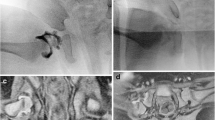Abstract
Background
Posterior hip dislocation in children and adolescents may involve the non-ossified posterior acetabular wall. Plain radiographs and computed tomography (CT) have been shown to underestimate injury to the unossified acetabulum as well as associated soft-tissue structures.
Objective
The purpose of this study was to describe findings on radiographs, CT and magnetic resonance imaging (MRI) after posterior hip dislocation in a series of adolescents and to report the intraoperative findings, which are considered the gold standard. Measurements of the posterior wall length using MRI and CT scans were also performed.
Material and methods
After institutional review board approval, 40 patients who sustained a traumatic posterior dislocation of the hip between September 2007 and April 2014 were identified. Inclusion criteria were (1) age younger than 16 years old and (2) availability of MRI obtained following closed reduction of the hip. Eight male patients and one female patient with an average age of 13.2 years (range: 10.1-16.2 years) underwent hip MRI following posterior dislocation. Seven of the nine patients also underwent evaluation by CT. Plain radiographs, CT scans and MRI were evaluated in all patients by a single pediatric radiologist blinded to surgical findings for joint space asymmetry, posterior wall fracture, femoral head fracture, labrum tear, complete or partial ligamentum teres rupture and presence of intra-articular fragments. Six patients underwent surgical treatment and the intraoperative findings were compared with the imaging findings.
Results
CT identified all bone injuries but underestimated the involvement of posterior wall fractures. Assessment of the posterior wall size and fracture displacement was possible with MRI. All surgically confirmed soft-tissue injuries, including avulsion of the posterior labrum, were identified preoperatively on MRI. The measurement of posterior wall length was not statistically different using CT and MRI.
Conclusion
Intraoperative pathological findings at the time of open surgical treatment were universally recognized on MRI but not on CT scans. MRI should be considered for evaluation of the hip following closed reduction for the treatment of a posterior dislocation in children and adolescents as it reliably allows assessment of intra-articular pathology without the risk of radiation exposure.



Similar content being viewed by others
References
Thompson VP, Epstein HC (1951) Traumatic dislocation of the hip; a survey of two hundred and four cases covering a period of twenty-one years. J Bone Joint Surg Am 33-A:746–778, passim
Vialle R, Odent T, Pannier S et al (2005) Traumatic hip dislocation in childhood. J Pediatr Orthop 25:138–144
Chun KA, Morcuende J, El-Khoury GY (2004) Entrapment of the acetabular labrum following reduction of traumatic hip dislocation in a child. Skeletal Radiol 33:728–731
Manner HM, Mast NH, Ganz R et al (2012) Potential contribution of femoroacetabular impingement to recurrent traumatic hip dislocation. J Pediatr Orthop B 21:574–578
Nepple JJ, Schoenecker PL, Clohisy JC (2011) Treatment of posttraumatic labral interposition with surgical hip dislocation and labral repair. Iowa Orthop J 31:187–192
Offierski CM (1981) Traumatic dislocation of the hip in children. J Bone Joint Surg (Br) 63-B:194–197
Shea KP, Kalamchi A, Thompson GH (1986) Acetabular epiphysis-labrum entrapment following traumatic anterior dislocation of the hip in children. J Pediatr Orthop 6:215–219
Vialle R, Pannier S, Odent T et al (2004) Imaging of traumatic dislocation of the hip in childhood. Pediatr Radiol 34:970–979
Elder G, Harvey EJ (2004) Surgical images: musculoskeletal. Imaging in musculoskeletal trauma: the value of magnetic resonance imaging for traumatic pediatric hip dislocations. Can J Surg 47:290–291
Fabricant PD, Hirsch BP, Holmes I et al (2013) A radiographic study of the ossification of the posterior wall of the acetabulum: implications for the diagnosis of pediatric and adolescent hip disorders. J Bone Joint Surg Am 95:230–236
Hearty T, Swaroop VT, Gourineni P et al (2011) Standard radiographs and computed tomographic scan underestimating pediatric acetabular fracture after traumatic hip dislocation: report of 2 cases. J Orthop Trauma 25:e68–73
Rubel IF, Kloen P, Potter HG et al (2002) MRI assessment of the posterior acetabular wall fracture in traumatic dislocation of the hip in children. Pediatr Radiol 32:435–439
Ganz R, Gill TJ, Gautier E et al (2001) Surgical dislocation of the adult hip a technique with full access to the femoral head and acetabulum without the risk of avascular necrosis. J Bone Joint Surg (Br) 83:1119–1124
AAPM (2008) American Association of Physicists in Medicine, Report 96: The Measurement, Reporting, and Management of Radiation Dose in CT. American Association of Physicists in Medicine, College Park, MD. http://www.aapm.org/pubs/reports/rpt_96.pdf. Assessed Jan 2015
AAPM (2011) American Association of Physicists in Medicine Report 204: Size-specific dose estimates (SSDE) in pediatric and adult body CT examinations (2011) American Association of Physicists in Medicine, College Park, MD. http://www.aapm.org/pubs/reports/rpt_204.pdf. Accessed 06 Feb 2015
Potter HG, Linklater JM, Allen AA et al (1998) Magnetic resonance imaging of articular cartilage in the knee an evaluation with use of fast-spin-echo imaging. J Bone Joint Surg Am 80:1276–1284
Calkins MS, Zych G, Latta L et al (1988) Computed tomography evaluation of stability in posterior fracture dislocation of the hip. Clin Orthop Relat Res 227:152–163
Keith JE Jr, Brashear HR Jr, Guilford WB (1988) Stability of posterior fracture-dislocations of the hip quantitative assessment using computed tomography. J Bone Joint Surg Am 70:711–714
Moed BR, Ajibade DA, Israel H (2009) Computed tomography as a predictor of hip stability status in posterior wall fractures of the acetabulum. J Orthop Trauma 23:7–15
Vailas JC, Hurwitz S, Wiesel SW (1989) Posterior acetabular fracture-dislocations: fragment size, joint capsule, and stability. J Trauma 29:1494–1496
Moed BR, Carr SE, Gruson KI et al (2003) Computed tomographic assessment of fractures of the posterior wall of the acetabulum after operative treatment. J Bone Joint Surg Am 85-A:512–522
Conflicts of interest
None
Author information
Authors and Affiliations
Corresponding author
Rights and permissions
About this article
Cite this article
Mayer, S.W., Stewart, J.R., Fadell, M.F. et al. MRI as a reliable and accurate method for assessment of posterior hip dislocation in children and adolescents without the risk of radiation exposure. Pediatr Radiol 45, 1355–1362 (2015). https://doi.org/10.1007/s00247-015-3317-9
Received:
Revised:
Accepted:
Published:
Issue Date:
DOI: https://doi.org/10.1007/s00247-015-3317-9




